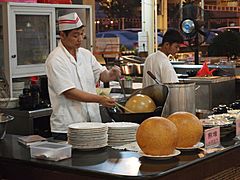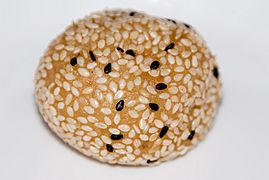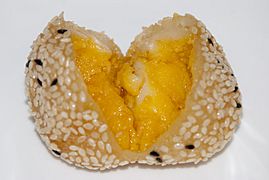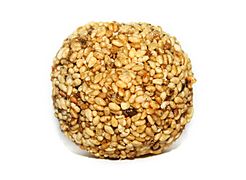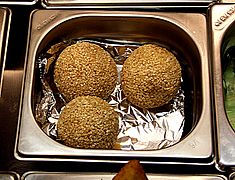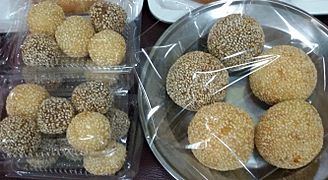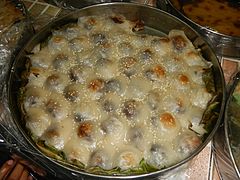Jian dui facts for kids
 |
|
| Alternative names | Matuan, sesame ball, sesame seed ball, buchi, onde-onde |
|---|---|
| Course | Tea, snack |
| Place of origin | Chang'an (now Xi'an), Tang dynasty (China) |
| Region or state | East Asia |
| Main ingredients | Glutinous rice flour, sesame seeds, various fillings (lotus seed, black bean, red bean pastes) |
| Jian dui | |||||||||||||||||||||||||
|---|---|---|---|---|---|---|---|---|---|---|---|---|---|---|---|---|---|---|---|---|---|---|---|---|---|
| Chinese | 煎䭔 | ||||||||||||||||||||||||
| Hanyu Pinyin | jiānduī | ||||||||||||||||||||||||
| Cantonese Yale | jīndēui | ||||||||||||||||||||||||
| Literal meaning | fried pile | ||||||||||||||||||||||||
|
|||||||||||||||||||||||||
| Sesame ball | |||||||||||||||||||||||||
| Chinese | 芝麻球 | ||||||||||||||||||||||||
| Hanyu Pinyin | zhīmáqiú | ||||||||||||||||||||||||
| Cantonese Yale | jīmàkàu | ||||||||||||||||||||||||
| Literal meaning | sesame ball | ||||||||||||||||||||||||
|
|||||||||||||||||||||||||
| Matuan | |||||||||||||||||||||||||
| Traditional Chinese | 麻糰 | ||||||||||||||||||||||||
| Simplified Chinese | 麻团 | ||||||||||||||||||||||||
| Hanyu Pinyin | mátuán | ||||||||||||||||||||||||
| Cantonese Yale | màtyùn | ||||||||||||||||||||||||
| Literal meaning | sesame rice dough | ||||||||||||||||||||||||
|
|||||||||||||||||||||||||
Jian dui (Chinese: 煎䭔; pinyin: jiānduī; Cantonese Yale: jīndēui; literally "fried dumpling") is a yummy fried Chinese pastry. It is made from a special flour called glutinous rice flour. This pastry is covered with sesame seeds on the outside. It is crispy and chewy.
Inside, the pastry is mostly hollow. This happens because the dough expands when it cooks. The hollow part is usually filled with a sweet paste. Common fillings include lotus paste, sweet black bean paste, or red bean paste. People also call them sesame balls (Chinese: 芝麻球; pinyin: zhīmáqíu; Cantonese Yale: jīmàkàu).
The name for jian dui can change depending on where you are in Asia. In northern China, it is known as matuan (麻糰). In northeast China, it is called ma yuan (麻圆). In Hainan, it is known as zhen dai (珍袋).
Contents
History of Jian Dui
The story of jian dui goes back a long time. It started in the Tang dynasty in Chang'an. This city is now known as Xi'an in China. Back then, it was a special food served in the palace. It was called lüdui (碌䭔).
A famous poet from the Tang dynasty, Wang Fanzhi, even wrote about this food. As people moved from central China to the south, they brought jian dui with them. This is how it became a part of southern Chinese cooking.
Jian Dui Across Asia
This delicious pastry is popular in many countries. Each place has its own name and sometimes a special way of making it.
East Asian Varieties
China
In Hong Kong, jian dui is a very common pastry. You can find it in most Chinese bakeries. This includes bakeries in Chinatown areas around the world.
Japan
In Japan, this pastry is called goma dango (goma dango (ごま団子, sesame dumpling)). You can often buy it at street fairs. It is also sold in Chinese neighborhoods and at many restaurants.
Korea
In Korea, it is known as jungguksik chamkkaegyeongdan (중국식 참깨경단). This means "Chinese-style sesame rice ball cake." This name helps people tell it apart from Korean-style sesame rice ball cakes. The Chinese jian dui is fried after being covered in sesame seeds. Korean gyeongdan is boiled first, then covered in toasted sesame seeds. So, jian dui is also called twigin chamkkaegyeongdan (튀긴 참깨경단), meaning "deep-fried sesame rice ball cake."
South Asian Varieties
India and Sri Lanka
In Tamil Nadu, India, and northeast Sri Lanka, it is called ellu urundai or ellurundai (எள்ளுருண்டை). This local word means "sesame ball." In Sinhalese, it is called Thuri Guli (තල ගුලි), which also means "sesame ball." It comes in different sizes and colors. It is usually filled with sesame seeds, jaggery, sugar, or a sweet syrup.
Southeast Asian Varieties
Cambodia
In Cambodia, it is called num kroch (នំ ក្រូច). People believe it came from China. The name num kroch means "cake orange" in Khmer. This is because its round shape looks like an orange. The filling for num kroch is made from mung beans. The outside is made of glutinous rice flour, which makes it a bit stretchy. Like many Asian desserts, num kroch is not too sweet.
Indonesia
In Indonesian cuisine, it is known as onde-onde or kue moci. It is filled with a sweet mung bean paste. People usually eat it as a snack. This pastry is also very popular in the Netherlands. You can find it in Indonesian and Vietnamese shops there.
Malaysia
In Malaysia, it is called kuih bom. This version is often filled with sweet shredded coconut or nuts. Sometimes, it might have red bean paste inside. Among the Hakka people in Sabah, jian dui is more commonly known as you chi.
Philippines
In the Philippines, jian dui is called butsi (Spanish: buchi). Chinese people have lived in the Philippines for hundreds of years. Because of this, Chinese foods like buchi became very popular. It is now a well-known part of Chinese Filipino food. It is sometimes linked to good luck.
Many local restaurants and even fast-food chains like Chowking sell buchi. Besides the usual lotus and red bean paste, some butsi use local ingredients. For example, some have ube (purple yam) flavor. Unlike jian dui, Filipino buchi can also be boiled or steamed. Other similar Filipino treats include mache and masi.
Vietnam
In Vietnam, there are two similar dishes. They are called bánh cam (from southern Vietnam) and bánh rán (from northern Vietnam). Both have a drier filling made from sweet mung bean paste. Bánh rán often smells like jasmine flowers.
Bánh rán can be sweet or savory. The sweet one has a mung bean filling. The savory one is filled with chopped meat, noodles, mushrooms, and other Vietnamese ingredients. It is usually served with vegetables and a dipping sauce.
Jian Dui Outside Asia
Mauritius
In Mauritius, the local Chinese community calls jian dui jien-yan-e (Chinese: 煎丸欸). However, it is more commonly known as "gato zinzli" in Creole. This means "sesame cake." It is one of the snacks in Mauritius that came from the Sino-Mauritian people.
The "gato zinzli" came from China. Chinese people from Guangzhou and Guangdong brought it to Mauritius in the 18th or 19th century. It is deep-fried until it is a bit chewy and crispy. Then, it is covered with sesame seeds. It is made from sweet potato, glutinous rice, and sometimes red bean paste. People eat them as snacks. They are especially eaten during Chinese New Year as a traditional treat by Sino-Mauritians. "Gato zinzli" are also shared with family and friends during Chinese New Year. This shows the spirit of sharing and friendship.
United States
In American Chinese restaurants and bakeries, this pastry is known as a sesame seed ball.
Gallery
-
Ellurundai, sesame ball in Sri Lanka
-
Indonesian onde-onde on display in "Indo Toko" in Amsterdam
-
Onde-onde from Surabaya, Indonesia: The yellow ones were made from white glutinous rice flour while the black ones from black glutinous rice flour.
-
Moche from the Philippines, a boiled buchi variant with bean paste filling served with sweetened coconut milk sauce
See also
 In Spanish: Jin deui para niños
In Spanish: Jin deui para niños


